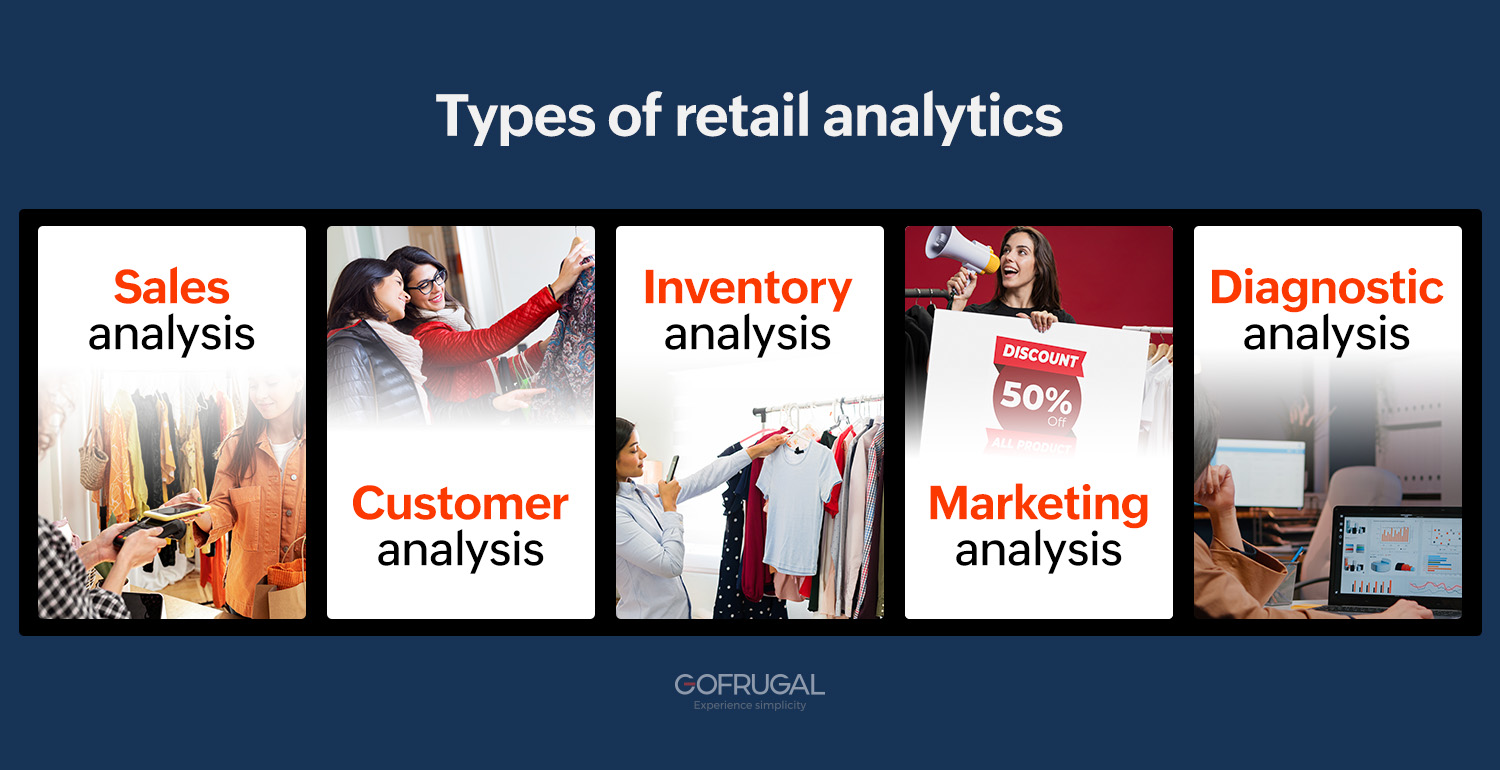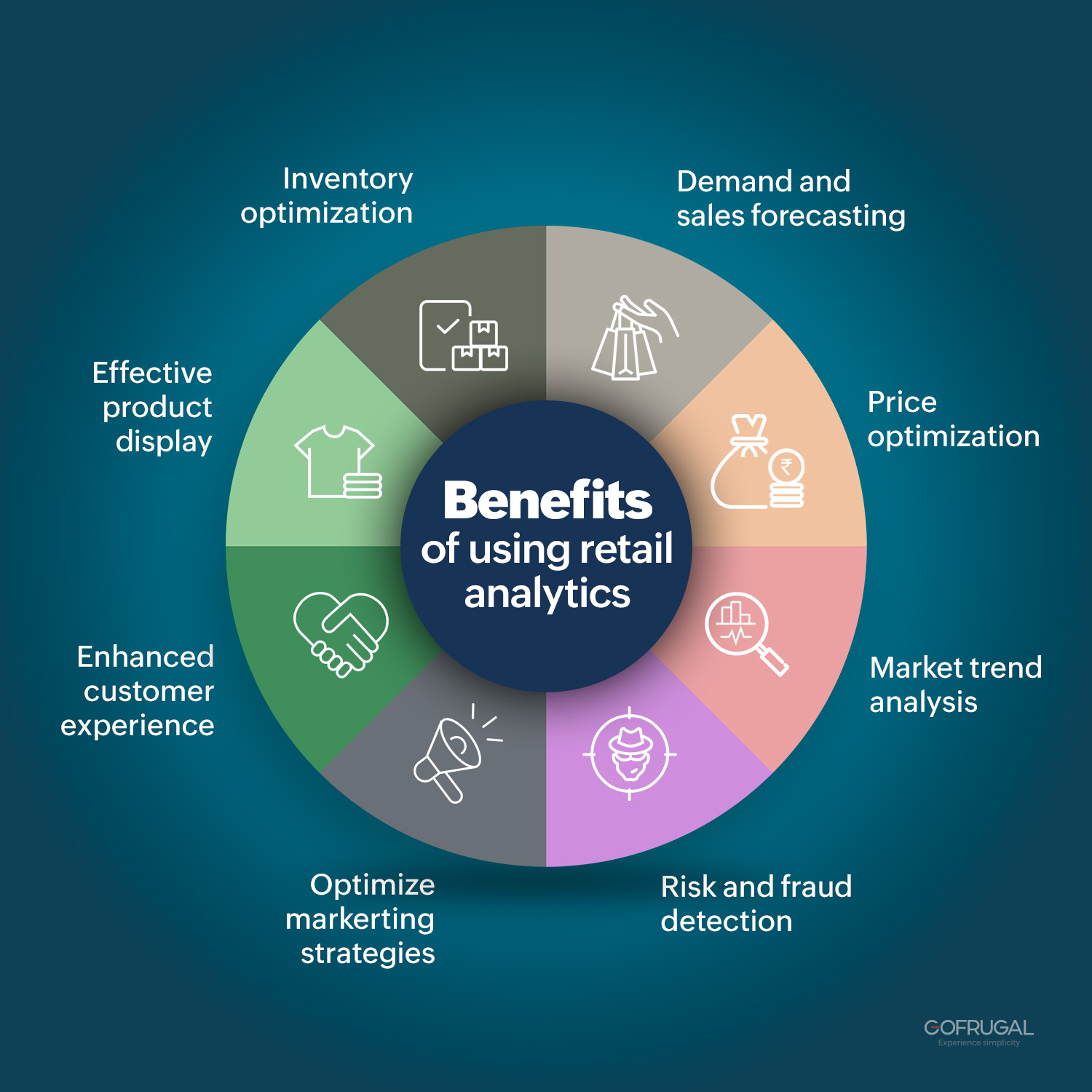Step into the shoes of a retail store owner, where every decision shapes the destiny of your business. Behind the scenes, retail analytics serves as your silent partner, guiding each move from inventory shelves to marketing campaigns. Recent studies show that businesses utilizing retail analytics experience significant boosts in sales and profitability. With the power of data-driven insights, retailers can unlock hidden patterns, foresee customer trends, and fuel their business expansion. Get ready to explore how retail analytics is revolutionizing the retail industry and discover practical insights that you can apply to your own business journey.
Contents
- What is retail analytics?
- Types of retail analytics
- Benefits of using retail analytics
- How retailers can use analytics
- Best practices of retail analytics
- How Gofrugal empowers retailers with its analytical tools
What is retail analytics?
Retail analytics, also termed retail data analytics, involves collecting, analyzing, and interpreting data to understand customer behavior, market trends, and store performance. It aids retailers in making informed decisions and improving store efficiency. Key components include predictive analytics for forecasting, omnichannel integration for seamless customer experiences, real-time insights for agile responses, personalization for tailored marketing, and competitive analysis for benchmarking against rivals.
Types of retail analytics
Retail store analytics encompasses various types of analytics that provide valuable insights into different aspects of retail operations. Here's an overview of the key types.
1. Sales analysis: This component involves tracking and analyzing sales performance to gain insights into various aspects of retail operations. It includes examining sales data across different products, categories, and time periods to identify trends, patterns, and areas of opportunity. By analyzing sales data, retailers can assess the effectiveness of marketing strategies, pricing tactics, and product assortments. Sales analysis also helps forecast future sales, set achievable targets, and measure the success of promotional campaigns.
2. Customer analysis: Customer analysis focuses on understanding the demographics, preferences, and purchasing habits of retail customers. It involves gathering data on customer behavior, such as shopping frequency, average transaction value, and preferred channels of interaction. By analyzing customer data, retailers can segment their customer base, personalize marketing efforts, and enhance customer experiences. Customer analysis helps retailers identify loyal customers, target new market segments, and improve customer retention through tailored promotions and communication strategies.
3. Inventory analysis: Inventory management encompasses the processes and strategies used to optimize inventory levels, turnover rates, and supply chain operations. It involves monitoring inventory levels in real time, forecasting demand, and ensuring adequate stock availability to meet customer demand. Effective inventory management helps retailers minimize stockouts, reduce excess inventory holding costs, and improve cash flow. By analyzing inventory data, retailers can identify slow-moving items, optimize reorder points, and streamline the procurement process for better efficiency.
4. Marketing analysis: This component focuses on evaluating the efficiency and impact of marketing campaigns and strategies. It involves analyzing data related to marketing efforts, such as promotional activities, advertising campaigns, and customer engagement initiatives. By measuring marketing effectiveness, retailers can determine the return on investment (ROI) of their marketing spend, identify the most successful channels and tactics, and allocate resources more efficiently to achieve their business objectives.
5. Diagnostic analytics: Diagnostic analytics digs deeper into data to understand why certain events occur. It helps retailers identify the root causes behind performance trends or anomalies, enabling them to address underlying issues and improve business processes.
Benefits of using retail analytics
- Improved decision-making: By leveraging retail analytics, businesses gain valuable insights into customer behavior, market trends, and operational efficiencies. These insights empower retailers to make informed decisions that drive growth and enhance profitability.
- Enhanced customer experience: Retail analytics enables businesses to understand customer preferences better and tailor their offerings accordingly. By analyzing data on customer interactions and feedback, retailers can personalize marketing campaigns, optimize pricing strategies, and deliver superior customer experiences.
- Optimized inventory management: With retail data analysis, businesses can predict demand patterns more accurately, leading to optimized inventory levels and reduced instances of stockouts or overstocking. This not only improves operational efficiency but also minimizes excess inventory costs.
- Increased sales and margins: Retail analytics helps businesses identify sales trends and opportunities for revenue growth. By analyzing customer purchasing behavior and product performance data, retailers can optimize pricing strategies, identify cross-selling opportunities, and maximize sales and margins.
- Competitive advantage: By staying ahead of emerging trends and consumer preferences through retail analysis, businesses can gain a competitive edge in the market. Retail analytics enables retailers to anticipate market shifts, tailor marketing strategies, and proactively adapt their offerings to outshine competitors.
How retailers can use analytics
Retailers can harness the power of analytics to improve various aspects of their operations and drive business growth. Here's how they can utilize analytics effectively.
- By analyzing past data, analytics provides insights into performance, diagnostic issues, suggests improvements, and forecasts demand. These insights empower retailers to optimize sales, profits, and customer satisfaction.
- By analyzing sales data and inventory levels, retailers can identify trends and forecast demand more accurately. For example, if analytics reveals that certain products are selling faster than others, retailers can adjust their inventory levels accordingly to prevent stockouts.
- Pricing analytics can help retailers determine the optimal pricing strategy for their products. By analyzing market trends, competitor pricing, and customer behavior, retailers can set prices that maximize profitability while remaining competitive. For instance, retailers can use dynamic pricing algorithms to adjust prices in real time based on demand and market conditions.
- In-store analytics leverage POS systems and video cameras to analyze customer behavior, optimize product placement, manage inventory levels, and deter theft.
- Customer analytics utilize data from multiple touchpoints to identify popular items, understand return patterns, and optimize marketing strategies.
- Merchandise analytics focuses on effective product display and pricing strategies to drive sales and improve profit margins.
- Web analytics track online consumer behavior to optimize website layout, pricing, and marketing promotions.
- Business intelligence reportsoffer preset KPIs to monitor trends and inform decision-making at all levels of the organization.
- Demand forecasting predicts online item demand based on customer interactions, while sales forecasting uses actual sales data to predict future sales and ensure adequate inventory management across all channels. These analytics tools collectively enable retailers to make data-driven decisions and stay ahead in a competitive market.
Best practices of retail analytics
Retail analytics is essential for retailers to make informed decisions and drive business growth. Here are key strategies and approaches to effectively implement and utilize retail analytics.
- Integrated data sources: Integrate various data sources such as sales data, customer data, inventory data, and external market data to gain a comprehensive view of business operations.
- Advanced analytics techniques: Utilize advanced analytics techniques like predictive modelling, machine learning, and AI algorithms to extract valuable insights and forecast future trends.
- Real-time analytics: Implement real-time analytics capabilities to monitor and respond to changing market conditions, customer behavior, and inventory levels promptly.
- Segmentation and personalization: Segment customers based on demographics, purchase history, and behavior to tailor marketing efforts and offers, enhancing customer experience and loyalty.
- Data visualization: Use data visualization tools to present insights in a clear and intuitive manner, enabling stakeholders to understand complex data and make informed decisions.
- Continuous improvement: Continuously refine analytics strategies and processes based on feedback, market dynamics, and technological advancements to stay competitive and drive innovation.
- Cross-functional collaboration: Foster collaboration between departments such as sales, marketing, and operations to ensure alignment and maximize the value derived from retail analytics.

How Gofrugal empowers retailers with its analytical tools
Gofrugal's analytics suite stands at the forefront of guiding retailers towards informed decisions and effortless execution.
- POS systems: Gofrugal's advanced POS systems track customer purchases, offering insights into sales patterns and popular items. This data empowers stores to optimize inventory levels and streamline checkout processes, enhancing customer satisfaction.
- CRM software: Gofrugal's CRM software facilitates effective customer interaction management, enabling personalized offers and promotions. You can execute a marketing campaign from Exclusife based on customer buying patterns.
- Business intelligence tools: Gofrugal's BI tools analyze vast data sets to extract actionable insights, aiding in informed decision-making. With intuitive dashboards and customizable reports, retailers identify growth opportunities and drive profitability.
- Inventory management systems:GoSure app provides advanced inventory management capabilities, including real-time stock updates and automated replenishment. It prevents stockouts and minimizes excess inventory costs, ensuring optimal inventory levels.
- Predictive analytics: Gofrugal's predictive analytics, exemplified by The Eye, enables purchase automation by forecasting future demand and optimizing purchasing decisions. With automated reorder suggestions and vendor performance analysis, retailers enhance operational efficiency and maximize profitability.
In conclusion, the transformative impact of retail analytics cannot be overstated. With the right tools and insights, retailers can navigate the complexities of the industry easily, driving success and growth. That's where Gofrugal's suite of analytical tools shines brightest. From advanced POS systems to intuitive CRM software and powerful predictive analytics, Gofrugal seamlessly integrates into every aspect of your retail operation, empowering you to make smarter decisions, streamline processes, and deliver exceptional customer experiences. With Gofrugal by your side, success becomes not just a goal, but a seamless journey towards retail excellence.



